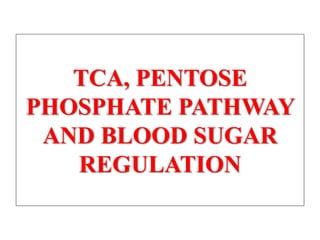
9.Tricarboxylic acid cycle, Pentose phosphate pathway and Blood sugar regulations (Biochemistry)
- 1. TCA, PENTOSE PHOSPHATE PATHWAY AND BLOOD SUGAR REGULATION
- 3. Citric Acid cycle or Tricarboxylic Acid cycle or Krebs Cycle •Reactions of Glycolysis are localized in Cytosol, and do not require any oxygen. whereas pyruvate dehydrogenase and TCA cycle reactions take place in mitochondria where oxygen is utilized to generate ATP by oxidative phosphorylation. Consumption of oxygen (respiration) depends on the rate of PDC and TCA reactions.
- 6. Historical perspective: 1930: Elucidation of Glycolysis Study of oxidation of glucose in muscle, addition of Malonate inhibited the respiration (i.e. O2 uptake). Malonate is an inhibitor of Succinate oxidation to Fumerate 1935: Szent-Gyorgyi: demonstrated that little amounts (catalytic amounts) of succinate, fumerate, malate or oxaloacetate acelerated the rate of respiration. He also showed the sequence of inter-conversion: Succinate --- Fumerate --- malate ---oxaloacetate. 1936: Martius & Knoop: Found the following sequence of reaction: Citrate to cis-aconitase to Isocitrate to a Ketogluterate to succinate 1937: Krebs: Enzymatic conversion of Pyruvate + Oxaloacetate to citrate and CO2 Discovered the cycle of these reactions and found it to be a major pathway for pyruvate oxidation in muscle.
- 8. Reaction of pyruvate dehydrogenase complex (PDC) Reactions of TCA cycle: 8 reactions: Citrate synthase Aconitase Iso-citrate dehydrogenase a ketoglutarate dehydrogenase Succinyl-Coenzyme A synthetase Succinate dehydrogenase Fumerase Malate dehydrogenase
- 11. Pyruvate dehydrogenase Complex (PDC) It is a multi-enzyme complex containing three enzymes associated together non-covalently: E-1 : Pyruvate dehydrogenase, uses Thiamine pyrophosphate as cofactor bound to E1 E-2 : Dihydrolipoyl transacetylase, Lipoic acid bound, CoA as substrate E-3 : Dihydrolipoyl Dehydrogenase FAD bound, NAD+ as substrate Advantages of multienzyme complex: 1. Higher rate of reaction: Because product of one enzyme acts as a substrate of other, and is available for the active site of next enzyme without much diffusion. 2. Minimum side reaction. 3. Coordinated control.
- 12. Reactions of Citric Acid Cycle 1. Citrate synthase: Formation of Citroyl CoA intermediate. Binding of Oxaloacetate to the enzyme results in conformational change which facilitates the binding of the next substrate, the acetyl Coenzyme A. There is a further conformational change which leads to formation of products. This mechanism of reaction is referred as induced fit model.
- 13. 2. Aconitase: This enzyme catalyses the isomerization reaction by removing and then adding back the water ( H and OH ) to cis-aconitate in at different positions. Isocitrate is consumed rapidly by the next step thus deriving the reaction in forward direction.
- 14. 3. Isocitrate dehydrogenase: There are two isoforms of this enzyme, one uses NAD+ and other uses NADP+ as electron acceptor.
- 15. 4. a-Ketoglutarate dehydrogenase: This is a complex of different enzymatic activities similar to the pyruvate dyhdogenase complex. It has the same mechanism of reaction with E1, E2 and E3 enzyme units. NAD+ is an electron acceptor.
- 16. 5. Succinyl CoA synthatse: Sccinyl CoA, like Acetyl CoA has a thioester bond with very negative free energy of hydrolysis. In this reaction, the hydrolysis of the thioester bond leads to the formation of phosphoester bond with inorganic phosphate. This phosphate is transferred to Histidine residue of the enzyme and this high energy, unstable phosphate is finally transferred to GDP resulting in the generation of GTP.
- 18. 6. Succinate Dehydrogenase: Oxidation of succinate to fumarate. This is the only citric acid cycle enzyme that is tightly bound to the inner mitochondrial membrane. It is an FAD dependent enzyme. Malonate has similar structure to Succinate, and it competitively inhibits SDH.
- 19. 7. Fumarase: Hydration of Fumarate to malate: It is a highly stereospecific enzyme. Cis-Maleate (the cis form of fumarate is not recognized by this enzyme.
- 20. 8. L-Malate dehydrogenase: Oxidation of malate to oxaloacetate: It is an NAD+dependent enzyme. Reaction is pulled in forward direction by the next reaction (citrate synthase reaction) as the oxaloacetate is depleted at a very fast rate.
- 21. Conservation of energy of oxidation in the CAC: The two carbon acetyl group generated in PDC reaction enter the CAC, and two molecules of CO2 are released in on cycle. Thus there is complete oxidation of two carbons during one cycle. Although the two carbons which enter the cycle become the part of oxaloacetate, and are released as CO2 only in the third round of the cycle. The energy released due to this oxidation is conserved in the reduction of 3 NAD+, 1 FAD molecule and synthesis of one GTP molecule which is converted to ATP.
- 23. Pentose Phosphate Pathway Also known as: • Pentose shunt • Hexose monophosphate shunt • Phosphogluconate pathway • It occurs in the cytosol.
- 24. One fate of G6P is the pentose pathway.
- 25. The pentose pathway is a shunt. • The pathway begins with the glycolytic intermediate glucose 6-P. • It reconnects with glycolysis because two of the end products of the pentose pathway are glyceraldehyde 3-P and fructose 6-P; two intermediates further down in the glycolytic pathway. • It is for this reason that the pentose pathway is often referred to as a shunt.
- 26. It’s a shunt
- 28. What does the pentose phosphate pathway achieve? • The pathway yields reducing potential in the form of NADPH to be used in anabolic reactions requiring electrons. • The pathway yields ribose 5-phosphate. – Nucleotide biosynthesis leading to: • DNA • RNA • Various cofactors (CoA, FAD, SAM, NAD+/NADP+).
- 32. 5 carbon atoms Regulatory enzyme
- 37. Don’t panic, you need not know all the reactions in detail; stay tuned.
